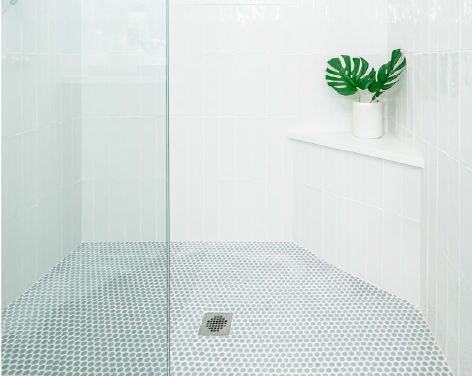How to Clean a Tile Shower: A Step-by-Step Guide for a Sparkling Bathroom

A clean tiled shower is essential for both hygiene and aesthetics, but with constant use, it can quickly accumulate soap scum, mildew, and hard water stains. Regular cleaning not only keeps your tile looking fresh but also prevents long-term build-up that’s harder to remove. Here’s a simple, step-by-step guide to make cleaning your shower easy and effective, whether it’s a weekly routine or a deeper scrub.
1. Gather Your Supplies
To efficiently clean a tiled shower, it’s helpful to have everything you need on hand. For most showers, you’ll need:
- All-purpose cleaner or bathroom cleaner (or vinegar and baking soda for a DIY option)
- Glass cleaner for any shower doors
- Scrub brush or sponge (use a non-abrasive type to avoid scratching surfaces)
- Grout brush or old toothbrush for tile grout
- Squeegee for drying surfaces
- Microfiber cloths for wiping and polishing
- Protective gloves to keep your hands safe from chemicals and grime
If you prefer natural cleaning solutions, white vinegar, baking soda, and lemon juice are effective alternatives for tackling most shower cleaning tasks.
2. Remove Items from the Shower
Start by removing any shampoo, conditioner, soap, and other personal items from your shower. Take out loofahs, shower mats, and any detachable shelves, as well. This will make it easier to clean the entire area without missing any spots and prevent product residue from interfering with your cleaning solution.
3. Ventilate the Bathroom
Make sure there’s plenty of ventilation while you clean, especially if you’re using strong cleaners. Open windows and turn on the exhaust fan to minimize fumes and help any moisture dry faster, reducing the risk of mold growth.
4. Spray Down the Walls and Floors
Spray an all-purpose or bathroom cleaner on the shower walls, floor, and fixtures. Allow the cleaner to sit for about 5-10 minutes to break down soap scum and loosen dirt. For natural cleaning, you can use a mixture of equal parts water and white vinegar or a baking soda paste for tougher spots.
Tip: Avoid using vinegar on natural stone tiles, as it can cause damage. Instead, opt for a stone-safe cleaner or mild dish soap with water.
5. Scrub the Shower Tiles and Grout
After letting the cleaner sit, use a scrub brush or sponge to scrub the tiles, paying special attention to areas with visible build-up. For grout, a grout brush or an old toothbrush works well to get into the crevices. You can sprinkle some baking soda on the grout lines for extra scrubbing power, then spray with vinegar (if the tile is vinegar-safe) and scrub.
If you have mold or mildew in the grout, a specialized grout cleaner with mildew-fighting ingredients may be necessary.
6. Clean the Shower Doors
Shower doors can accumulate hard water stains and soap scum, which can be tough to remove. Use a glass cleaner specifically formulated for shower glass, or create a homemade cleaner with equal parts white vinegar and water. Spray the solution on the door, let it sit for a few minutes, and then scrub with a non-abrasive sponge.
For stubborn stains, try making a paste with baking soda and water, apply it to the glass, and scrub gently. Rinse thoroughly, and use a squeegee to remove excess water for a streak-free finish.
7. Clean the Shower Head and Fixtures
Showerheads and metal fixtures are prone to mineral deposits and water stains. If your showerhead is detachable, you can soak it in a bowl of vinegar for an hour to dissolve the mineral buildup. For fixed showerheads, fill a plastic bag with vinegar, secure it around the showerhead with a rubber band, and let it soak.
After soaking, scrub the showerhead with a toothbrush to remove any remaining buildup, then run water through it to rinse.
8. Rinse Everything Thoroughly
Once you’ve scrubbed the walls, grout, doors, and fixtures, it’s time to rinse the entire shower thoroughly. Use warm water and a clean sponge to wipe away any remaining cleaner, dirt, and residue. This step is crucial, as leftover cleaner can leave streaks or cause buildup if not removed.
9. Dry and Polish
To keep your shower looking spotless for longer, dry all surfaces with a microfiber cloth or towel. This prevents water spots, especially on glass and metal fixtures. Wipe down any shower doors and metal fixtures to give them a final polish.
Using a squeegee to wipe down glass doors after each shower will help prevent soap scum and mineral buildup, making deep cleans easier.
10. Finish with Routine Maintenance Tips
Regular upkeep can make your weekly shower clean much easier. Try these maintenance tips:
- Keep a daily cleaner: Spraying a daily shower cleaner on tiles and glass can prevent buildup over time.
- Use a squeegee: A quick swipe with a squeegee after each shower will help keep glass doors spot-free.
- Ventilate the bathroom: Run the fan or open windows after showering to reduce moisture and prevent mold and mildew growth.
Cleaning your shower doesn’t have to be a daunting task when you break it down into simple, manageable steps. With the right tools and a few natural solutions, you can keep your tile shower spotless and extend the life of your tiles, grout, and fixtures. Regular upkeep will save you time and effort in the long run, leaving your shower looking fresh and inviting every day.
Note that other, non-tiled, shower wall materials typcially should be cleaned with soap, water, and non-abrasive cloth.
Cleaning Not Cutting It Anymore?
If you’re looking for a shower upgrade or remodel to make cleaning even easier, reach out to Bath Tune-Up for professional design and installation services tailored to your style and needs. Contact us today to learn more!

